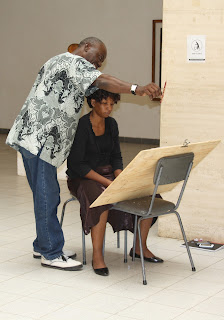By Andrew Mulenga
+you+want+what.jpg) |
| You Want What? by Antoinette du Rand |
Once again the Zebra Crossing Cafe, that cosy little restaurant along Lusaka’s Addis Ababa Drive is host to small yet delightful exhibition by little known artists of foreign extraction.
The show that has been on display since February 2 and runs until the end of the month has no particular theme but features reasonably priced paintings of wildlife by the likes of Helen Gray, cattle by Storm Treger, some humorous entries of plump mice and dragons by Antoinette du Rand and some neo-impressionist portraits by Linda Castle.
It is obvious that the works were not done by professional artists, if anything they might as well be a collection of works from a part time art club, but they are entertaining and enjoyable nonetheless.
As you enter the restaurant area you are greeted by a huge portrait of a bull entitled ‘A Welcome Burden’ by Treger, alongside it is ‘You Want What’ a playful caricature of what looks like a mouse standing akimbo with a hard gaze and bug-eyes that look like eight balls off a pool table by Antoinette du Rand. But Linda Castle has probably one of the most remarkable pictures on display; ‘Man With Pipe’that depicts a bearded, old and wrinkled Caucasian seated on the floor smoking a pipe with half a glass of what might be scotch whiskey. Although this painting has a dreary and somewhat austere backdrop, the gawky, and seemingly irregular anatomy of the subject in the portrait gives the work a certain authenticity as a painting, one is tempted to describe it as ‘a painter’s painting’.
The next two viewing spaces in the restaurant are a bit more synchronised with regards a specific theme. In one corner you find explosively colourful renditions of floral arrangements and in the other you find a collection of game portraits, cheetahs, lions, elephant while the last viewing space is occupied by a couple of stone nude torsos, depictions of polo, a beach front, probably images that the artists captured while on holiday.
+Man+with+pipe.jpg) |
| Man With Pipe by Linda Castle |
Most of the work on display is reasonably priced, this however does not fully suggest that the work is from an amateur milieu, but rather, the artists do not depend entirely on selling their work to earn a living. Clearly they all paint and draw for fun in their free time and are quite comfortable selling their works for as little as K100, 000 (one hundred thousand kwacha). They are almost certainly content with having their work viewed and judged publicly in the first place, to make a sale at any price would be a bonus in itself.
The Zebra Crossing Cafe continues to be consistent as an alternative exhibition venue for local and foreign artists and one can only hope management continues supporting the arts by providing a venue.
Meanwhile, “Love Affairs” a solo exhibition by Lawrence Yombwe, one of Zambia’s most significant and plagiarised artists is now showing at the Alliance Francaise along Alick Nkhata Road in Lusaka. The show features Yombwe’s signature ’Mbusa’ style with his usual hazy browns and blues and is a definite ‘must see’ for all art lovers and collectors. The exhibition’s write-up reads as follows: “LOVE AFFAIRS they are among the host of issues that shape man’s existence under the sun, we remain blind to this reality until we intently ponder on life in and around us. Only when we patiently observe do we realise that life depends on these subtle patterns and rhythms that work for every individual. When surprised we should not hesitate to stop or even retreat until certain of where to place our next step, the true test is when we last.” Yombwe’s show runs until February 29.
Look out for the full review of Yombwe’s exhibition next week in your Saturday Post. 
+2nd+year+BA+Fine+Art+student+Rabecca+Mwanza.jpg)

